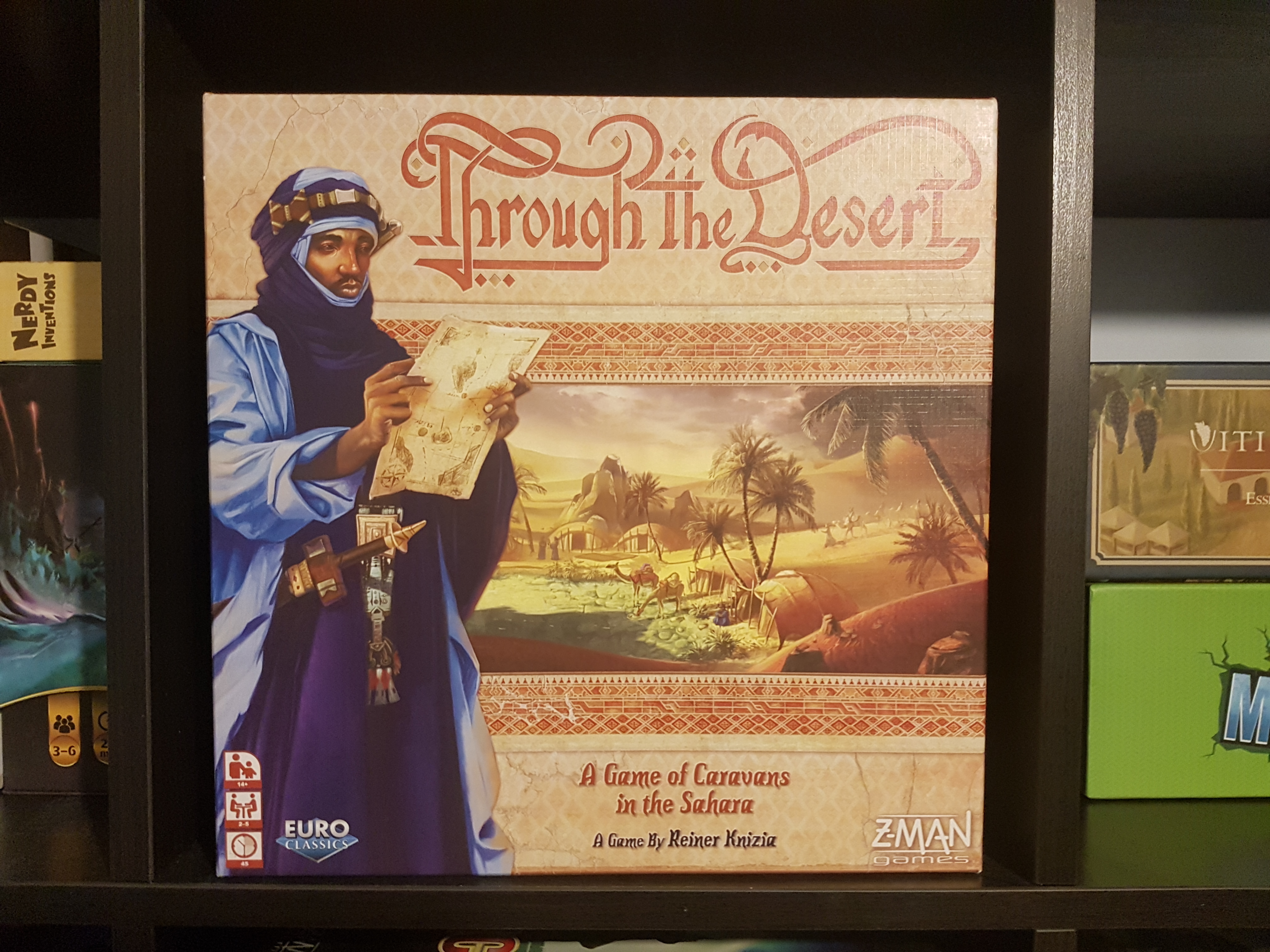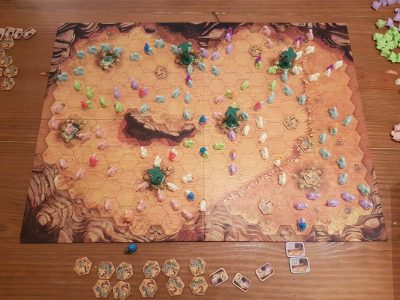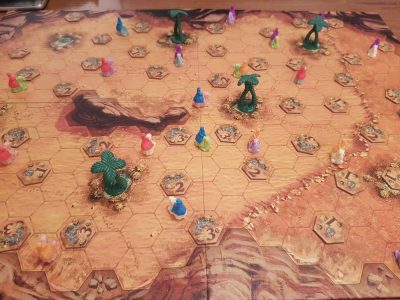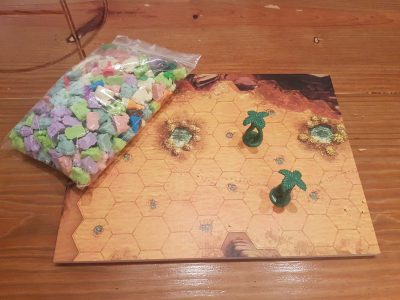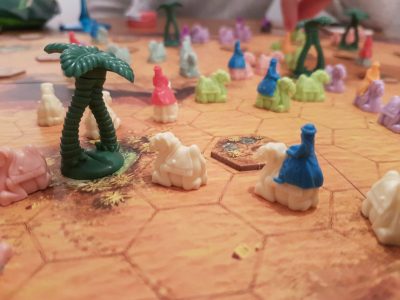Through The Desert was originally released 20 years ago, in 1998, and has just been reprinted by Z-Man Games. The board game, from designer Reiner Knizia, is all about route building and camels. 2 – 5 Players will strategize and plan routes across the desert, building up camel caravans to venture to waterholes and an oasis or two. However, did Through The Desert deserve a reprint or should this have been only a mirage? Let’s find out!
To setup the game one of the two sides of the game board must be chosen. For the first few games the mountain side is recommended, as the river adds a slight variant (it’s a minor addition to scoring for players remember, where crossing the river awards 5 points). After this the cardboard waterhole tokens must be randomly distributed across the board onto denoted waterhole locations and plastic palm trees added onto the oases. Once the board is almost littered with tokens players get to claim a camel of each of the five colours. To mark it as their own a leader, in the player’s colour, is clipped on top of the camel, in a rider position.
In turn each player now places their 1 of their 5 leader camels onto the board. For the first leader placement each player must choose a different coloured camel, thereafter they can place any leader camel. When placing leaders they cannot be on a waterhole token and must not be adjacent to an oasis or another leader. Once all leader camels are placed the game is ready to go and becomes all about placing pastel camels in long caravan style trains across the board.
For the rest of the game players perform the same action each turn, of taking two camels from the communal draw piles and adding them onto the board. The camels drawn can be the same or different in colour, the choice is up to the player. When placing a camel it must be adjacent to your own caravan of matching colour but it cannot be adjacent to another players caravan of the same colour: this would wrongly connect the two. If this results in a leader being linked to an oasis for the first time 5 points is awarded to the player. If instead the camel is placed on top of a waterhole token that token, worth 1 – 3 points, is gained by the player.
The final way to gain points during play, on the mountain side of the game board, is to make an enclosed area. This is done by either making a loop on the board, where your camel caravan makes some kind of circle, or linking to two points of the edge of the board. At the end of the game tokens within the enclosed area are obtained by the player, as well as 5 points being awarded for any enclosed oases. On top of this, a single point is awarded for each enclosed hexagon.
The game continues with players taking two camels on a turn until one colour of camels runs out. At this point 10 points are awarded to the player with the longest caravan of each colour, so 50 points are up for grabs. If two players tie for the longest caravan of a colour 5 points are awarded to both of them. At this time, points are counted and the winner is crowned.
Camels, caravans and oasis are all terms people will know, so nothing special has been invented, or oddly named, for the sake of adding ways to gain points, or to make the game sound overly fancy. Combine this with the ease of turns, with one consistent action to perform, and you have an extremely assessible title. Within the time taken to set up Through The Desert the rules can have been fully explained and players will already see in front of them every way to score points. This is extremely important to those new to the hobby, or when playing with younger gamers, as it means there is less to remember, letting them get into the game and enjoy it quicker.
Making new players feel they are accomplishing something is taken care of, as during a game of Through The Desert players will earn a tonne of points. It is incredibly rare to go more than 2 turns in a row without scoring at least 1 point from a waterhole token. New players may not instantly be able to compete with those with a few games under their belts, in terms of the placement strategies and importance of enclosed areas. However, after a quick game or two they will most likely be up to speed enough to pose competition.
Carving off a section of the map is incredibly powerful at getting points and stopping others having access to specific oases. After a couple of games this will have undoubtedly been spotted by players and the placement of leader camels will start to become more strategic. Players will learn they must react to the randomly distributed oases and waterhole tokens, rather than just starting on the side of the board closest to them. Soon what was a family friendly camel-fest becomes all about blocking off your opponents and so the slightly cutthroat side of Through The Desert surfaces!
Looking in the box, or when the game is initially set up, there are a lot of tokens. This does make the setup time a little lengthy if no one else jumps in to help: especially when having to sort the mini-mountains of colourful camels into sets. The quantity of tokens should result in a game board that looks and feels incredibly busy but the colours used for the waterhole tokens allows them to somewhat blend into the scene, not detracting from the desert vista.
Through The Desert takes place across a wonderfully illustrated board. A desert themed board could have so easily been drab and dull, instead there is a warmth to the sand colours. The little uses of rocks, a mountain or a river depending on the side of the board and all sizes of waterholes break up any potential monotony. Even the colour difference in the sand, used to denote where is in play for games with higher player counts, adds to the visual presentation.
Z-Man Games had an opportunity to create a game with vividly coloured camels, carving routes across the desert, but they have instead opted for pastel colours. Not everyone will agree but this great decision limiting the in-your-face-ness of the visual experience. This helps the colourful leaders riding on the camels to stand out, making what is a busy board clearer to read. Some will still make the odd mistake in the midst of the crowded camel caravans, yet mistakes will be a lot rarer thanks to the choice of colour palette.
Despite their being a huge bag of tokens at key times, somehow, there is still not enough. It would be incredibly helpful to have tokens for 1-point denominations to score the enclosed areas at the end of the game. Instead, players will either be grabbing a pen and paper or a calculator to add everything up. I don’t mind having to count points at the end a game when the points are all on tokens or all on the board. Alas, when most are on tokens and then the rest need to be added from enclosed hexagons on the board the mental maths becomes a bit of a chore.
Having never before played Through The Desert it was great to get this gem of a game to the table. The board can get incredibly busy if players are all focusing on different colours. To counter this, as the only action is so simple players can spend their time judging where to place camels and reading the board. This is how Through The Desert circumvents the busy board issue and most onlookers see the blob of camels as at least intriguing. The double-sided board does add in some variation into the game but the most important feature are the elevation zones. These maintain the same fast paced, intertwining caravan feel into games with a lower player count. The gameplay isn’t deep enough to hold gamers attention for hours on end, yet Through The Desert’s entertainment value certainly isn’t a mirage.
[Editor’s Note: Through The Desert was provided to us for the review by Z-Man Games.]

